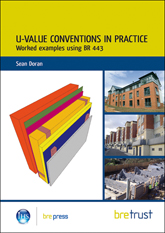U-value conventions in practice: Worked examples using BR 443
BRE (Building Research Establishment) is an independent, research-based consultancy, testing and training organisation, operating in the built environment and associated industries.
U-value conventions in practice: Worked examples using BR 443 was written by Sean Doran and published by BRE on 13 Jan 2012. The 36 page publication helps designers develop a better understanding of how to calculate U-values and kappa-values for use in calculation tools. See also Conventions for U-value calculations (2006 edition) BR 443.
U-values, (sometimes referred to as thermal transmittances) measured in W/m²K represent how effective elements of a buildings fabric are as insulators. That is, how effective they are at preventing heat from transmitting between the inside and outside of a building. The lower the U-value of an element of a building's fabric, the more slowly heat is able to transmit through it, and so the better it performs as an insulator.
Kappa values (sometimes referred to as thermal mass values) measured in kJ/m2K represent the heat capacity per square metre of a material. This is used to quantify the thermal mass of building elements such as walls and floors. The higher the kappa-value, the greater the thermal mass, that is the more heat the element is able to store.
These values are integral to the use of energy calculation tools such as the Standard Assessment Procedure (SAP) and the Simplified Building Energy Model (SBEM), which support Part L of the Building Regulations, Conservation of Fuel and Power. As a result, it is important that they are calculated reliably.
U-value conventions in practice:
- Supports the Building Regulations Part L and other legislation on the energy performance of buildings.
- Helps raise an awareness of and understanding of U-values and kappa-values.
- Encourages a unified, consistent approach to calculating U-values and kappa-values.
- Explains calculation methods using worked examples for wall, roof and floor designs.
- Supports training programmes for practitioners carrying out energy assessments and using U-value calculation software.
- Provides guidance about calculating U-values using standard simplified methods.
Its contents include:
- Introduction.
- Summary outline of the U-value calculation method.
- The worked examples.
- References and further reading.
[edit] Related articles on Designing Buildings
- Approved document L.
- BRE articles on Designing Buildings Wiki.
- Building regulations.
- Building Research Establishment.
- Conventions for calculating linear thermal transmittance and temperature factors.
- Conventions for U-value calculations (2006 edition) BR 443.
- Energy performance certificate.
- Insulation.
- Kappa value.
- PA ratio.
- Simplified Building Energy Model.
- Standard Assessment Procedure.
- Thermal bridge.
- Thermal mass.
- U value.
- What do design professionals need to know about U-value calculation conventions?
Featured articles and news
Government consultations for the summer of 2025
A year of Labour, past and present consultations on the environment, the built environment, training and tax.
CMA competitiveness probe of major housing developers
100 million affordable housing contributions committed with further consultation published.
Homes England supports Greencore Homes
42 new build affordable sustainable homes in Oxfordshire.
Zero carbon social housing: unlocking brownfield potential
Seven ZEDpod strategies for brownfield housing success.
CIOB report; a blueprint for SDGs and the built environment
Pairing the Sustainable Development Goals with projects.
Types, tests, standards and fires relating to external cladding
Brief descriptions with an extensive list of fires for review.
Latest Build UK Building Safety Regime explainer published
Key elements in one short, now updated document.
UKGBC launch the UK Climate Resilience Roadmap
First guidance of its kind on direct climate impacts for the built environment and how it can adapt.
CLC Health, Safety and Wellbeing Strategy 2025
Launched by the Minister for Industry to look at fatalities on site, improving mental health and other issues.
One of the most impressive Victorian architects. Book review.
Common Assessment Standard now with building safety
New CAS update now includes mandatory building safety questions.
RTPI leader to become new CIOB Chief Executive Officer
Dr Victoria Hills MRTPI, FICE to take over after Caroline Gumble’s departure.
Social and affordable housing, a long term plan for delivery
The “Delivering a Decade of Renewal for Social and Affordable Housing” strategy sets out future path.
A change to adoptive architecture
Effects of global weather warming on architectural detailing, material choice and human interaction.
The proposed publicly owned and backed subsidiary of Homes England, to facilitate new homes.
How big is the problem and what can we do to mitigate the effects?
Overheating guidance and tools for building designers
A number of cool guides to help with the heat.
The UK's Modern Industrial Strategy: A 10 year plan
Previous consultation criticism, current key elements and general support with some persisting reservations.
Building Safety Regulator reforms
New roles, new staff and a new fast track service pave the way for a single construction regulator.



























Comments